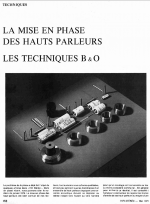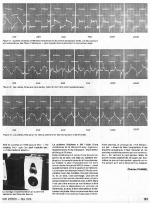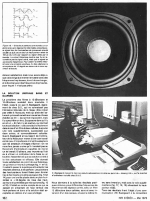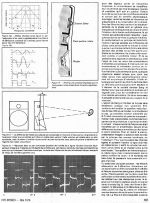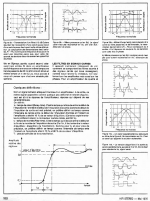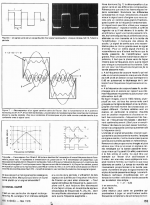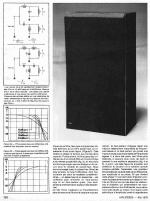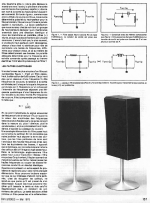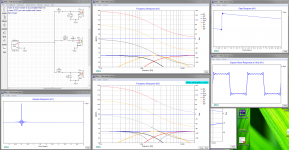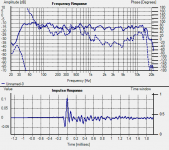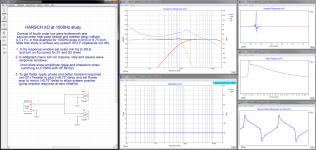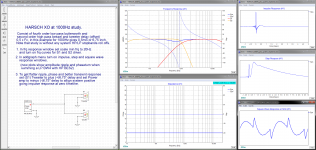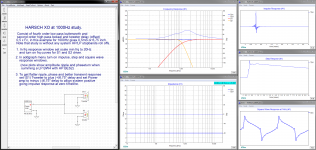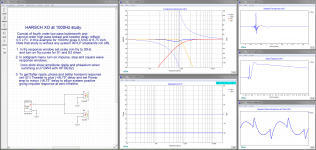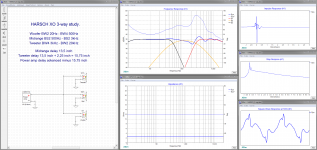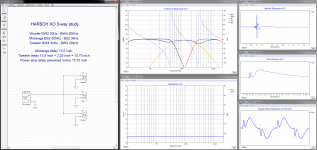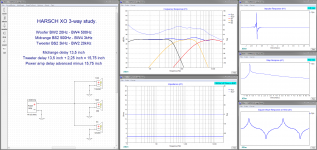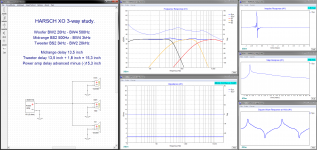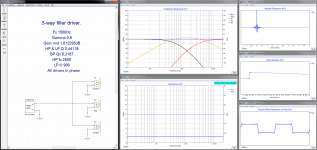Yes, it's interesting how B&O classify this as a 2-way speaker based on woofer and tweeter frequencies and XO point as the middle is just to correct the phase anomalies from the 2-way. It's still a 3-way in my book - anytime a mid is that extensive and "prominent".
I agree today DSP and FIR lets us fix all of this but very cool how an all analog solution existed in the 70's. I wish they had actual measurements to share.
The math is without a doubt, elegant. I love when a proof ends with F(s)=1.
From "Filler" driver ala B&O thread ...
Attachments
Byrtt,
Thanks for the link to this wonderful article.
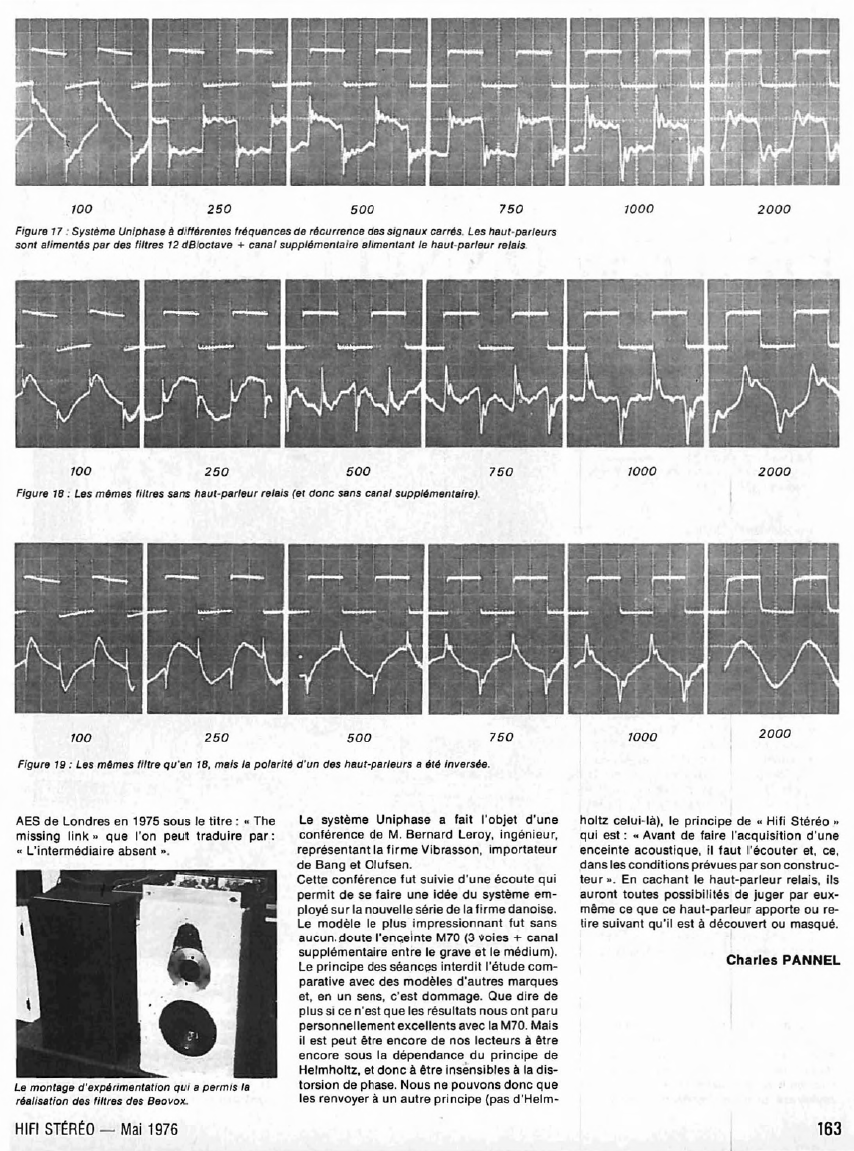
The above square waves are extraodinarily good for an all analog passive XO.
The trick is find wide bandwidth drivers with flat response.
The 10F/8424 as mid here would be excellent but limited SPL. The AC130F1 is also quite a formidable mid driver with wide bandwidth and smooth response.
Thanks for the link to this wonderful article.

The above square waves are extraodinarily good for an all analog passive XO.
The trick is find wide bandwidth drivers with flat response.
The 10F/8424 as mid here would be excellent but limited SPL. The AC130F1 is also quite a formidable mid driver with wide bandwidth and smooth response.
New crossover.
Electrical slopes. Acoustic doesn't seem too different though.
LR24 low pass on woofer @ 400
LR12 bandpass @ 270 and 1.5K
LR24 high pass on tweeter @ 1.5K
Woofers, 2X18
Mid/tweet, 12" OB coaxial
This looks very good - a symmetric Harsch 3-way. What kind of delays are you using? Also, what drivers are you using?
Can you show a step response of the system too?
Mid delay - 1.54ms
Tweeter - 1.28ms
All drivers lined up on the same mounting plane. I got these delay values when trying the hole filler method in the other thread. Did the reverse null method until everything clicked. Then I tried to minimize overlap as much as possible while maintaining phase. I changed LR12-6-12 to LR24-12-24 without changing delays. Re eq'ed slightly to fix response.
Trying to download REW at the moment. Will post when I have results.
Drivers:
Ciare NDCX12-1.4 - Ciare NDCX12-1.4 is a lightweight neodymium coaxial speaker for all 2 or 3-way speaker systems- Ciare Speakers - Ciare NDCX12-1.4 12" coaxial lighweight neodymium speaker for high quality speaker systems. Ciare NDCX12-1.4 coaxial s
(These were a better value in 2013)
B&C 18PS76 18" Woofer
Tweeter - 1.28ms
All drivers lined up on the same mounting plane. I got these delay values when trying the hole filler method in the other thread. Did the reverse null method until everything clicked. Then I tried to minimize overlap as much as possible while maintaining phase. I changed LR12-6-12 to LR24-12-24 without changing delays. Re eq'ed slightly to fix response.
Trying to download REW at the moment. Will post when I have results.
Drivers:
Ciare NDCX12-1.4 - Ciare NDCX12-1.4 is a lightweight neodymium coaxial speaker for all 2 or 3-way speaker systems- Ciare Speakers - Ciare NDCX12-1.4 12" coaxial lighweight neodymium speaker for high quality speaker systems. Ciare NDCX12-1.4 coaxial s
(These were a better value in 2013)
B&C 18PS76 18" Woofer
Last edited:
HARSH study including two zipped attached files that can be opened in free XSim software (download here: XSim free crossover designer).
First two pictures with just XO point and infinite system bandwidth. Picture 1 raw LP BW4 and HP BES2 as they sum firing in sync without offset, picture 2 have 6,75 inch offset (0,5mS) for tweeter.
Last two pictures with XO point and system bandwidth limit in stop-bands at BW2 20Hz and BW2 20kHz. Picture 3 raw LP BW4 and HP BES2 as they sum firing in sync without offset, picture 4 have 6,75 inch offset (0,5mS) for tweeter.
Study was made by linking a frd-file with right slopes to each of the drivers.
Slopes was created in Rephase as IR wav-file imported to REW then exported as frd-file to link to drivers in XSim.
Have fun tweaking offset and on the fly see traces in plot windows change.
First two pictures with just XO point and infinite system bandwidth. Picture 1 raw LP BW4 and HP BES2 as they sum firing in sync without offset, picture 2 have 6,75 inch offset (0,5mS) for tweeter.
Last two pictures with XO point and system bandwidth limit in stop-bands at BW2 20Hz and BW2 20kHz. Picture 3 raw LP BW4 and HP BES2 as they sum firing in sync without offset, picture 4 have 6,75 inch offset (0,5mS) for tweeter.
Study was made by linking a frd-file with right slopes to each of the drivers.
Slopes was created in Rephase as IR wav-file imported to REW then exported as frd-file to link to drivers in XSim.
Have fun tweaking offset and on the fly see traces in plot windows change.
Attachments
Last edited:
I'm having problems trying to implement the Harsch XO on a 3-way.
I was going for an electrical XO at 500 and 3K but can't seem to get decent spl respons or step.
First measurement of current LR2 XO at 500 and 3K
I'm using a 15 cycles frequency dependent window. All measurements at 65cm distance, on axis, between mid and tweeter.
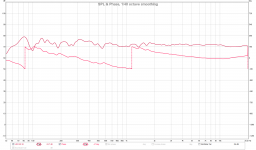
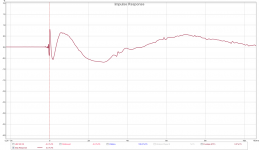
Settings used in Najda for Harsch XO
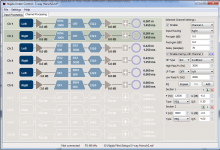
I then increased delay for mid-tweeter vs woofer from 40 to 80 samples while keeping tweeter delay vs mid constant at 10 samples but can't seem to find the "wiggles" or a decent looking step.
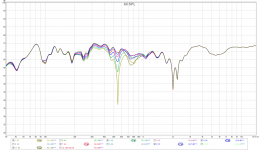
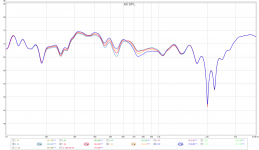
The step for the flattest SPL respons (delay 64 samples) seems very wrong
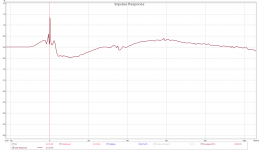
I am using a 225Hz Q12 -6db shelf on all channels for bafflestep correction, before I only had it on the woofer channel, didn't seem to make much difference.
I was going for an electrical XO at 500 and 3K but can't seem to get decent spl respons or step.
First measurement of current LR2 XO at 500 and 3K
I'm using a 15 cycles frequency dependent window. All measurements at 65cm distance, on axis, between mid and tweeter.


Settings used in Najda for Harsch XO

I then increased delay for mid-tweeter vs woofer from 40 to 80 samples while keeping tweeter delay vs mid constant at 10 samples but can't seem to find the "wiggles" or a decent looking step.


The step for the flattest SPL respons (delay 64 samples) seems very wrong

I am using a 225Hz Q12 -6db shelf on all channels for bafflestep correction, before I only had it on the woofer channel, didn't seem to make much difference.
Last edited:
I'm having problems trying to implement the Harsch XO on a 3-way.....
A first thought is have you drivers polarity set right, they all need to be in same polarity and not as LR2 where you probably either has mid or woofer/tweeter section reversed.
Last edited:
It's tricky to do a 3-way. My suggestion is to do a 2-way with the mid and tweeter first. Look at the overlay of step response of each individually and combined with "Overlay" window. I can see that delays are off - tweeter looks like it needs more delay so that the sharp spike lines up with the start of the rising shoulder of the mid. The overlay plot makes this obvious and gives you idea of how much delay you need. The problem is that the inherent delays doe to depth of cone and voice coil relative to baffle varies with drivers. You can measure that acoustic offset with an interferogram. Measure tweeter and mid separately running full range and in parallel. Load all 3 minimum phase FRD into a simulation program like PCD or Xsim and adjust acoustic offset until resulting prediction matches parallel trace with every dip and wiggle perfectly. That is then the native acoustic offset and amount of delay you need to consider as part of the Harsch XO delay.
Once you get the mid and tweet to work, treat mid and tweet as a single driver and add woofer. Whatever delays needed now get applied to both mid and tweet simultaneously to move delay as a group.
Hope that helps.
Once you get the mid and tweet to work, treat mid and tweet as a single driver and add woofer. Whatever delays needed now get applied to both mid and tweet simultaneously to move delay as a group.
Hope that helps.
It was one of the first things I checked and why I remeasured the LR2 XO to see if there was a fault in wiring. I can set polarity in Najda: LR2 has ++--++, Harsch is all ++++++
Okay then that point is cleared, then can think of two reasons for errors first is if you look at study post 149 HARSH is all about setting the right accurate offset and second reason is are you sure slopes are the right acoustic slopes at microphone point in space. By this mean setting a electric BW4 does not secure acoustic slope is exactly BW4 without further EQing so the acoustic slope gets exactly as electric textbook one would look like.
Should i do it myself would create three bandpass electric textbook frd-files (LF/MF/HF) that then is imported into REW as a target help to get the three bandpass sections filtered one by one so they throw the right slope acoustic to microphone. If requested can help and upload three frd-target files if you like.
After that investigate what the inherent real offset is between LF/MF/HF on the actual baffle, because this real offset is needed to extract or add to the calculated offset for HARSH XO.
Byrtt has good point about acoustical filter slope needs to match. The electrical filter may not give correct shape. First thing is to EQ response as flat as possible up to 2 octaves above or below XO of possible. It helps to have large bandwidth natively flat drivers to start. On one of my drivers I ended up using 1st order electrical which was 2nd order acoustic. That made a big difference. Sometimes an LR2 electrical combined with natural response makes a better looking Bessel 2.
Thank you for the swift replies. I'm using a SS 22W discovery, 10F8414g10 and ND25FA-4. The LR2 has an electrical XO at 700 but it's more like 500 acoustical so that's probably the biggest reason I couldn't get the Harsch right. I allready have the acoustic offsets by inverting mid polarity in LR2 and changing delays to get the deepest nulls. (5 samples mid-woofer and 2 samples tweet-mid at 1 meter on axis between mid and tweet)
I'm waiting for Charlie to fix the spreadsheets to work with recent versions of OpenOffice to get decent data for the woofer but that shouldn't matter much for the mid-tweet.
If BYRTT would be so kind to upload the target responses, I'll try and get the mid-tweet Harsch going tomorrow.
I'm waiting for Charlie to fix the spreadsheets to work with recent versions of OpenOffice to get decent data for the woofer but that shouldn't matter much for the mid-tweet.
If BYRTT would be so kind to upload the target responses, I'll try and get the mid-tweet Harsch going tomorrow.
Zschimmel,
Excellent drivers for this. The 8414 is a perfect wideband mid ideally suited and the ND25FA is something I have. It works best XO above 4K in my opinion. I think I successfully used it in a transient perfect with a TG9FD (similar in performance to 10F/8414. I think I ended up using it first order XO symmetric at 4K with TG9FD for transient perfect in top. You can use this combo on top and the Harsch between the woofer and the mid/tweet combo.
Here is my TG9 and ND25FA in a tiny OB.
http://www.diyaudio.com/forums/mult...ct-3way-nearfield-monitor-13.html#post4495375
Here is the TG9FD and ND25FA with symmetric 1st order at 4K and a Harsch XO at 300Hz with a dipole Z baffle woofer.
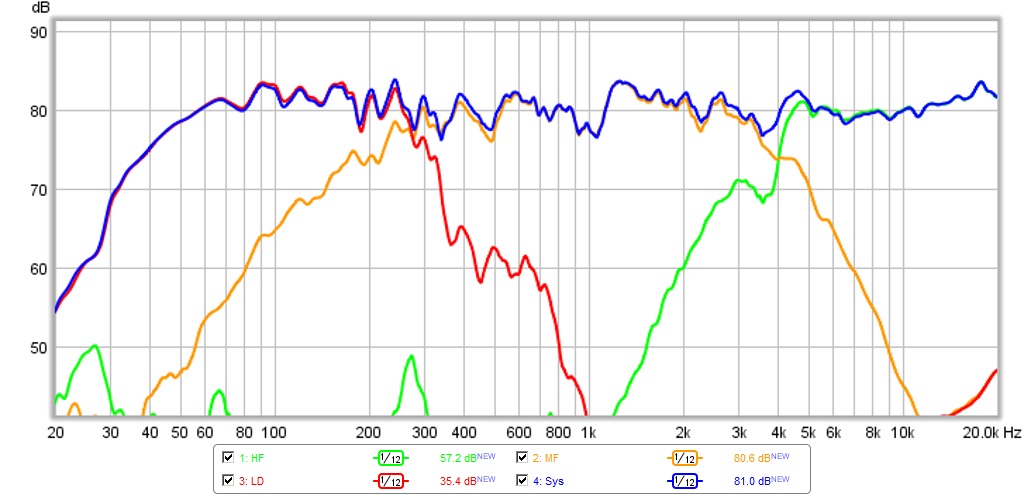
Excellent drivers for this. The 8414 is a perfect wideband mid ideally suited and the ND25FA is something I have. It works best XO above 4K in my opinion. I think I successfully used it in a transient perfect with a TG9FD (similar in performance to 10F/8414. I think I ended up using it first order XO symmetric at 4K with TG9FD for transient perfect in top. You can use this combo on top and the Harsch between the woofer and the mid/tweet combo.
Here is my TG9 and ND25FA in a tiny OB.
http://www.diyaudio.com/forums/mult...ct-3way-nearfield-monitor-13.html#post4495375
Here is the TG9FD and ND25FA with symmetric 1st order at 4K and a Harsch XO at 300Hz with a dipole Z baffle woofer.

Last edited:
Nice drivers Zonneschimmel, attached is zip-folder with 3x frd-files where SPL is set to 90dB and is close to SS 22W else just offset them into REW to suit measurement setup sensitivity, target slope responses is set:
BW2 20Hz - BW4 500Hz
BS2 500Hz - BS2 3kHz
BW4 3kHz - BW2 20kHz
Was not so lucky when setting this setup up into XSim but maybe i have delays wrong for tweeter, picture 1 show system with all three driver firing in sync without offset and seems right but in picture 2 where delays are set only XO point for LF/MF seems smooth but XO point for MF/HF gets a lot of ripple. Have i calculated offset wrong in setting 13,5 inch for mid and 13,5 inch + 2,25 inch for tweeter.
BW2 20Hz - BW4 500Hz
BS2 500Hz - BS2 3kHz
BW4 3kHz - BW2 20kHz
Was not so lucky when setting this setup up into XSim but maybe i have delays wrong for tweeter, picture 1 show system with all three driver firing in sync without offset and seems right but in picture 2 where delays are set only XO point for LF/MF seems smooth but XO point for MF/HF gets a lot of ripple. Have i calculated offset wrong in setting 13,5 inch for mid and 13,5 inch + 2,25 inch for tweeter.
Attachments
As seen previous post can't get low amplitude ripple for mid/tweeter XO having bandpass driver as BS2 stopbands, have tried sweeping delay offset up and down while watching frq response and transient plots and it doesn't help.
Below seems get less amplitude ripple and better transients, setting woofer to BW2 20Hz - BW4 500Hz, midrange to BS2 500Hz - BW4 3kHz, and tweeter to BS2 3kHz -BW2 20kHz. First picture is with same delays as calculated in previous post but as seen in picture 2 a little less delay for tweeter gives even less ripple without degrading transients compared to picture 1, find frd-files attached below for these slopes.
Picture 3 show a good performer should it happen the three drivers SS 22W discovery, 10F8414g10 and ND25FA-4 can cover the wideband needed for filler driver XO ala B&O, find also frd-files attached below for these slopes.
Below seems get less amplitude ripple and better transients, setting woofer to BW2 20Hz - BW4 500Hz, midrange to BS2 500Hz - BW4 3kHz, and tweeter to BS2 3kHz -BW2 20kHz. First picture is with same delays as calculated in previous post but as seen in picture 2 a little less delay for tweeter gives even less ripple without degrading transients compared to picture 1, find frd-files attached below for these slopes.
Picture 3 show a good performer should it happen the three drivers SS 22W discovery, 10F8414g10 and ND25FA-4 can cover the wideband needed for filler driver XO ala B&O, find also frd-files attached below for these slopes.
Attachments
Last edited:
Great work Byrtt. So you are saying the mirror image BS2-BS2 bandpass doesn't work and we have to BW4-BS2 LPF-HPF combos always? Great that you caught this with your electronic experiment. With a real drivers response thrown in, maybe when I implemented it - it resembled this more. Great finding.
Thanks.
X
Thanks.
X
- Home
- Loudspeakers
- Multi-Way
- S. Harsch XO
